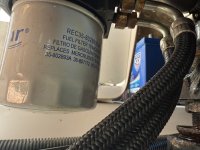Tristan1985
Cadet
- Joined
- Dec 21, 2024
- Messages
- 18
Hi all,
We have a Mercruiser 4.3L MPi 2005 model and we have just undertaken a full engine rebuild and we are now having persistent Low fuel Pressure issues.
Serial number - OW324384
The pressure is consistently around 33 PSI when running at 1800 rpm. When we turn the key a few times without starting engine the pressure can climb to around 40 but then as soon as the engine runs it drops to 33 and the pressure gauge needle does jump around a bit.
We have replaced with new fuel pump at time of rebuild, we then replaced the pressure regulator
when the flow pressure issue was discovered. However this didn’t fix the problem.
Some notes-
When you squeeze the return line from the pressure regulator to the fuel filter and you squeeze it right we can get the pressure to sit at 43, this is what made us think it was the regulator as the pump is capable of pumping to required pressure. But replacing the regulator didn’t fix the problem.
We have placed a second tank connected to the fuel filter to see if it was an issue with the tank/lines. No change.
We have even today rigged up a bike pump to pressurise the fuel line to the fuel filter to check for leaks between fuel filter and fuel rail. We originally found a leak where the fuel line attaches to the pump side of the fuel filter and thought this has to be it. We removed the nuts and retightened, no leak but problem still exists.
When the pump runs it sounds like it’s got air in it but I’m really not sure.
We are at a loss now as to what it is???
Thinking remains issues could be power related or faulty new pump, maybe collapsing fuel lines or air getting in somewhere still?
Any help please and thankyou.
We have a Mercruiser 4.3L MPi 2005 model and we have just undertaken a full engine rebuild and we are now having persistent Low fuel Pressure issues.
Serial number - OW324384
The pressure is consistently around 33 PSI when running at 1800 rpm. When we turn the key a few times without starting engine the pressure can climb to around 40 but then as soon as the engine runs it drops to 33 and the pressure gauge needle does jump around a bit.
We have replaced with new fuel pump at time of rebuild, we then replaced the pressure regulator
when the flow pressure issue was discovered. However this didn’t fix the problem.
Some notes-
When you squeeze the return line from the pressure regulator to the fuel filter and you squeeze it right we can get the pressure to sit at 43, this is what made us think it was the regulator as the pump is capable of pumping to required pressure. But replacing the regulator didn’t fix the problem.
We have placed a second tank connected to the fuel filter to see if it was an issue with the tank/lines. No change.
We have even today rigged up a bike pump to pressurise the fuel line to the fuel filter to check for leaks between fuel filter and fuel rail. We originally found a leak where the fuel line attaches to the pump side of the fuel filter and thought this has to be it. We removed the nuts and retightened, no leak but problem still exists.
When the pump runs it sounds like it’s got air in it but I’m really not sure.
We are at a loss now as to what it is???
Thinking remains issues could be power related or faulty new pump, maybe collapsing fuel lines or air getting in somewhere still?
Any help please and thankyou.




















